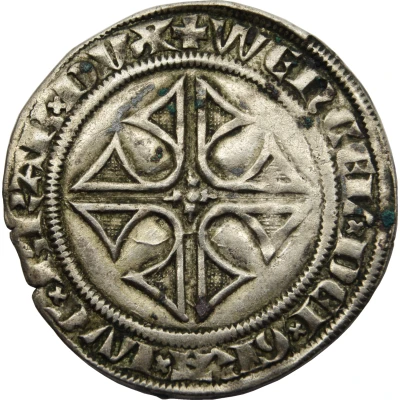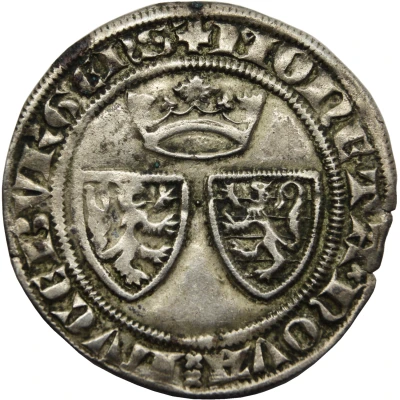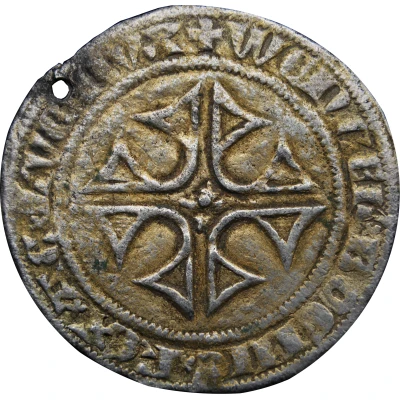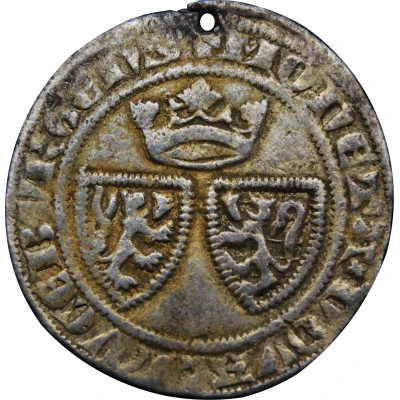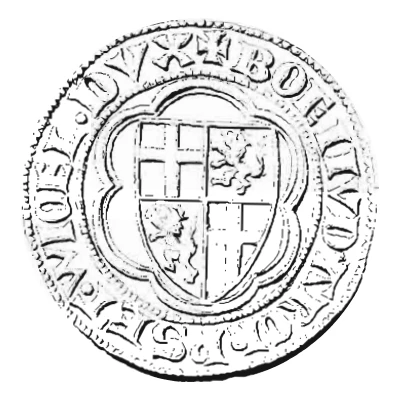
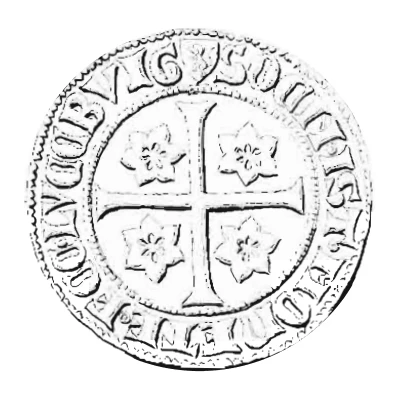

© M. de la Fontaine, 1842
Gros - Wenceslaus I Luxembourg-Trèves ND
| Silver | 3.42 g | - |
| Issuer | Duchy of Luxembourg (Luxembourg) |
|---|---|
| Duke | Wenceslaus I (1353-1383) |
| Type | Standard circulation coin |
| Years | 1359-1362 |
| Value | 1 Gros (1⁄40) |
| Currency | Florin (1353-1713) |
| Composition | Silver |
| Weight | 3.42 g |
| Shape | Round (irregular) |
| Technique | Hammered |
| Demonetized | Yes |
| Updated | 2024-10-06 |
| Numista | N#95790 |
|---|---|
| Rarity index | 95% |
Reverse
Long patted cross, quartered with four stars with six points, perforated.
Legend between two pearled circles.
Script: Latin (uncial)
Lettering: SOCII₀ IST'₀ MOnETE₀ FCE₀ LVCEBVRG'
Lettering (regular font): SOCII₀ IST'₀ MONETE₀ FCE₀ LVCEBVRG'
Translation:
Socii istius monetae factae in Lucemburgo
Solidarity money struck in Luxembourg
Edge
Plain
Comment
Gros, very rare, struck between 1359 and 1362 at the Luxembourg-city mint.1 gros = 1/30 golden florin
1 gros = 5 esterlins = 30 deniers
Coin from the monetary union between Wenceslaus I, Duke of Luxembourg (1353-1383) and Bohemond of Saarbrücken, Archbishop of Trier (1354-1362). "On October 31, 1359, Wenceslas concluded a very close alliance with Bohemond of Saarbrücken. The strike of a social coin was the consequence of this good diplomatic agreement" (Bernays and Vannerus, 1910).
From this alliance results the striking of 2 gros, 2 tiers and 2 sixth of gros, each time a version tréviroise and a Luxembourghish, recognizable by the difference on the shield and the legend. The shield is quartered so that the first quarter is always occupied by the one at the beginning of the legend. In this case (version tréviroise), first district of Trier and beginning with the legend of the archbishop.
(for the Luxembourgish version, first district of Bohemia and Wincel at the beginning of the legend).
Bohemond dies quickly, the alliance was renewed with his successor but does not seem to have spawned the production of coins.
Description of this piece by M. de la Fontaine, 1842, RBN, vol. 1
The average weight of 9 pieces analyzed was 3.42 g.
Extreme weights: 2.84 and 3.69 g. (Weiller, p. 69)
Quite a few variants of legend and punctuation are known.
- Obverse:
a. +BOEMVD'₀ ARChPS₀ ET₀ WICEL'₀ DVX (Bureled Luxembourgisch quarter)
b. +BOEMVD'₀ ΛRЄhPS₀ ET₀ WICEL'₀ DVX (Non-bureled Luxembourgish quarter)
- Reverse:
a. SOCII₀ IST'₀ MOnETE₀ FCЄ₀ LVCЄBVRG'
b. SOCII₀ IST'₀ MOnETE₀ FCЄ₀ LVCЄBVRG (without apostrophe after BVRG)
c. SOCII₀ IST ₀ MOnETE₀ FCЄ₀ LVCЄBVRG' (without apostrophe after IST)
d. SOCII₀ IST'₀ MOnETE₀ FCЄ₀ LVCЄBVIG
e. SOCII₀ IST'₀ MOnETE₀ FCC₀ LVCCBVRG'
Legend begins at 12 o'clock with a Luxembourgish shield.
Source:the illustrations on this card come from the article written by
M. de la Fontaine and published by theRBN in 1842, pl. XV, fig. A1.
Interesting fact
One interesting fact about the Standard circulation coin Gros - Wenceslaus I (Luxembourg-Trèves) ND (1359-1362) from Duchy of Luxembourg (Luxembourg) made of Silver weighing 3.42 g is that it features an image of Wenceslaus I, also known as Wenceslas I, who was the Duke of Luxembourg from 1353 to 1383. He was a member of the House of Luxembourg and was known for his military campaigns and his role in the politics of the Holy Roman Empire. The coin's design includes an image of Wenceslaus I on one side and a depiction of a shield with the Luxembourg coat of arms on the other. This coin is a rare and valuable piece of numismatic history, and its silver content makes it a popular collector's item.
